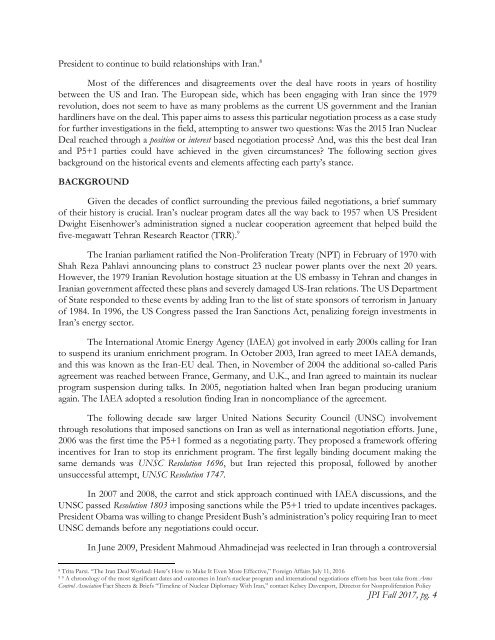Fall 2017 JPI
Create successful ePaper yourself
Turn your PDF publications into a flip-book with our unique Google optimized e-Paper software.
President to continue to build relationships with Iran. 8<br />
Most of the differences and disagreements over the deal have roots in years of hostility<br />
between the US and Iran. The European side, which has been engaging with Iran since the 1979<br />
revolution, does not seem to have as many problems as the current US government and the Iranian<br />
hardliners have on the deal. This paper aims to assess this particular negotiation process as a case study<br />
for further investigations in the field, attempting to answer two questions: Was the 2015 Iran Nuclear<br />
Deal reached through a position or interest based negotiation process? And, was this the best deal Iran<br />
and P5+1 parties could have achieved in the given circumstances? The following section gives<br />
background on the historical events and elements affecting each party’s stance.<br />
BACKGROUND<br />
Given the decades of conflict surrounding the previous failed negotiations, a brief summary<br />
of their history is crucial. Iran’s nuclear program dates all the way back to 1957 when US President<br />
Dwight Eisenhower’s administration signed a nuclear cooperation agreement that helped build the<br />
five-megawatt Tehran Research Reactor (TRR). 9<br />
The Iranian parliament ratified the Non-Proliferation Treaty (NPT) in February of 1970 with<br />
Shah Reza Pahlavi announcing plans to construct 23 nuclear power plants over the next 20 years.<br />
However, the 1979 Iranian Revolution hostage situation at the US embassy in Tehran and changes in<br />
Iranian government affected these plans and severely damaged US-Iran relations. The US Department<br />
of State responded to these events by adding Iran to the list of state sponsors of terrorism in January<br />
of 1984. In 1996, the US Congress passed the Iran Sanctions Act, penalizing foreign investments in<br />
Iran’s energy sector.<br />
The International Atomic Energy Agency (IAEA) got involved in early 2000s calling for Iran<br />
to suspend its uranium enrichment program. In October 2003, Iran agreed to meet IAEA demands,<br />
and this was known as the Iran-EU deal. Then, in November of 2004 the additional so-called Paris<br />
agreement was reached between France, Germany, and U.K., and Iran agreed to maintain its nuclear<br />
program suspension during talks. In 2005, negotiation halted when Iran began producing uranium<br />
again. The IAEA adopted a resolution finding Iran in noncompliance of the agreement.<br />
The following decade saw larger United Nations Security Council (UNSC) involvement<br />
through resolutions that imposed sanctions on Iran as well as international negotiation efforts. June,<br />
2006 was the first time the P5+1 formed as a negotiating party. They proposed a framework offering<br />
incentives for Iran to stop its enrichment program. The first legally binding document making the<br />
same demands was UNSC Resolution 1696, but Iran rejected this proposal, followed by another<br />
unsuccessful attempt, UNSC Resolution 1747.<br />
In 2007 and 2008, the carrot and stick approach continued with IAEA discussions, and the<br />
UNSC passed Resolution 1803 imposing sanctions while the P5+1 tried to update incentives packages.<br />
President Obama was willing to change President Bush’s administration’s policy requiring Iran to meet<br />
UNSC demands before any negotiations could occur.<br />
In June 2009, President Mahmoud Ahmadinejad was reelected in Iran through a controversial<br />
8 Trita Parsi. “The Iran Deal Worked: Here’s How to Make It Even More Effective,” Foreign Affairs July 11, 2016<br />
9 9 A chronology of the most significant dates and outcomes in Iran’s nuclear program and international negotiations efforts has been take from Arms<br />
Control Association Fact Sheets & Briefs “Timeline of Nuclear Diplomacy With Iran,” contact Kelsey Davenport, Director for Nonproliferation Policy<br />
<strong>JPI</strong> <strong>Fall</strong> <strong>2017</strong>, pg. 4
















